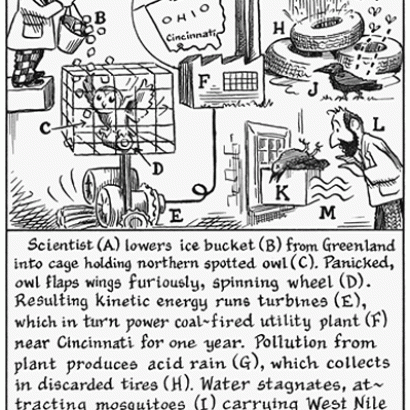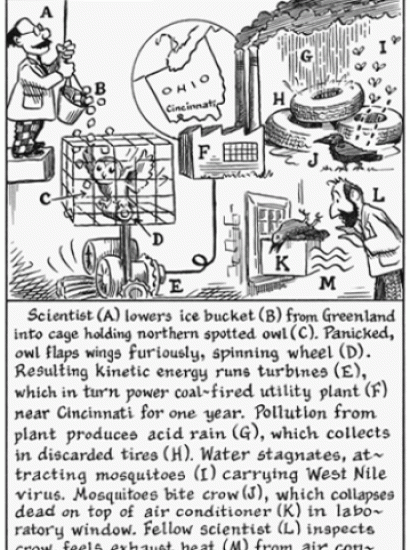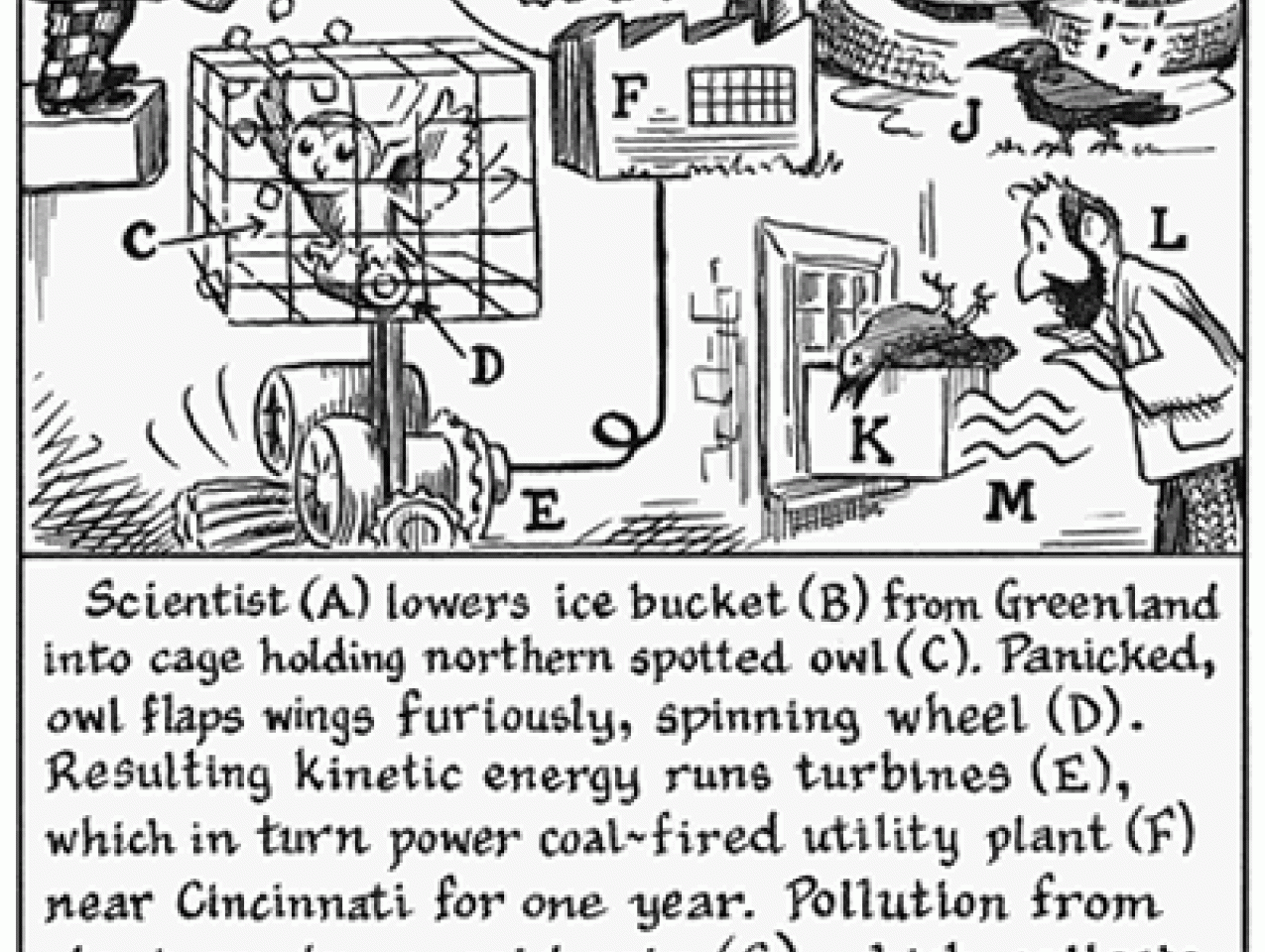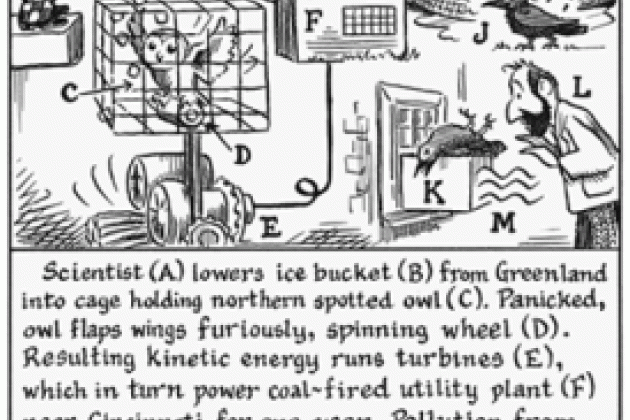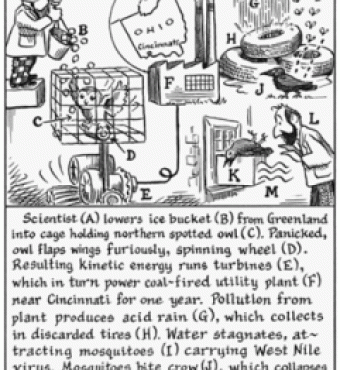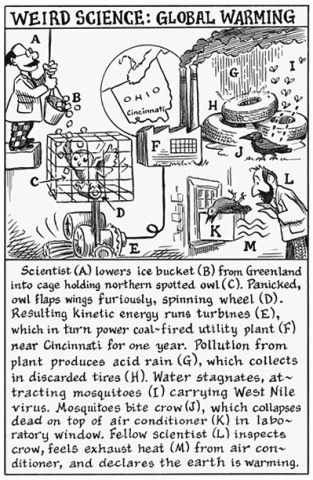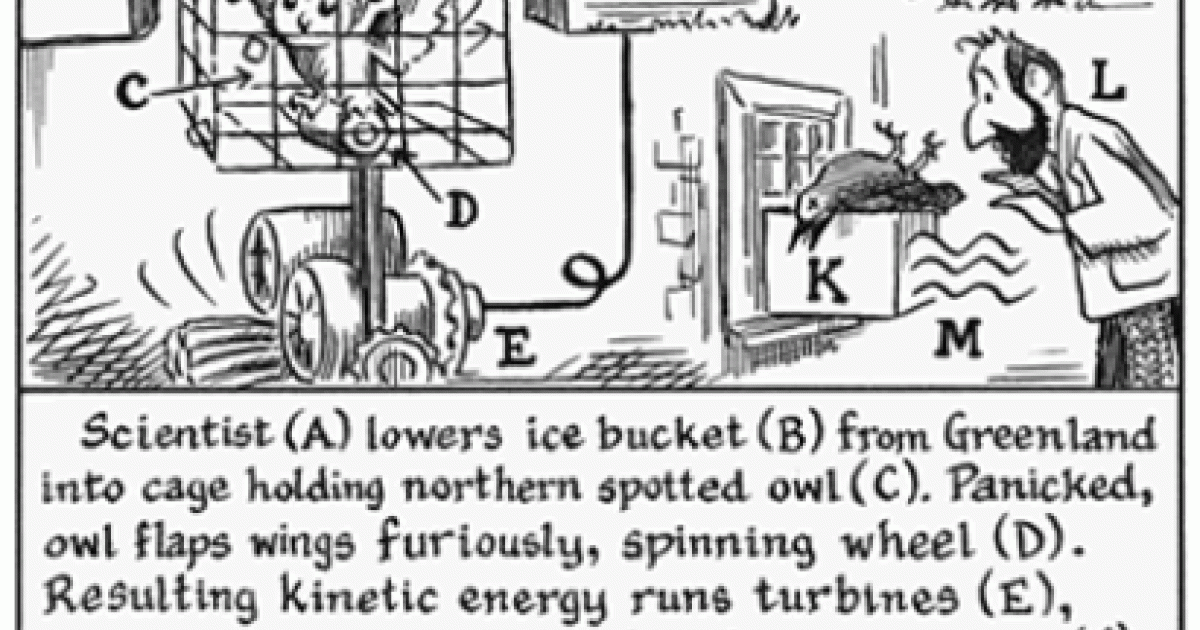- Energy & Environment
Last March the Bush administration announced that it would not abide by the Kyoto Protocol, the 1998 treaty that would have required the United States and other industrial countries to reduce their output of "greenhouse gases"—carbon dioxide and other gases that trap heat and contribute to global warming.
The president’s decision was just icing on the cake—the Kyoto Protocol was so ambiguous and overreaching that it was probably doomed in any case—but the issue is unlikely to go away. Recent polls, including a Gallup survey taken earlier this year, show why. Most Americans have some concerns about global warming: 35 percent of those polled worry a "great deal" and 28 percent worry a "fair amount." About two-thirds believe global warming is mainly caused by human activities—specifically, industrial production and energy consumption.
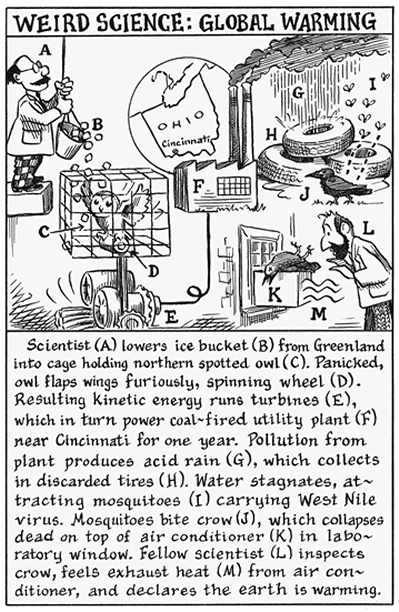
| Illustration by Taylor Jones for the Hoover Digest.
|
|
Our allies in Europe are also bound to keep up the heat. Just about every party and potential coalition on the left side of the political spectrum has staked a position on global warming designed to win enviro-leaning voters. Indeed, the current government in Germany holds office only with the support of the Green Party. European leaders raced for the opportunity to paint President Bush as Attila the Hun in his disregard for the future of civilization. (Never mind that no European country had implemented the Kyoto treaty, either.)
|
Global warming? There is probably no other issue today about which so many hold such strong views with so little firsthand knowledge. |
In short, global warming has achieved the status of dogma in modern politics, despite the fact that the average citizen has devoted little serious study to the issue nor has the typical political official. There is probably no other issue today about which so many hold such strong views with so little firsthand knowledge.
The Climate Data Conundrum
Global warming is unlike any other environmental issue. Usually the health hazards of a pollutant like asbestos or benzene are well documented at the level of the individual subject. Estimating the hazards they present to the environment and the public as a whole is mainly a problem of scaling so that we can limit average exposure rates.
Not so global warming. There is good direct evidence suggesting global temperatures have indeed been rising lately. Weather watchers throughout the literate world have been recording local temperatures for about two centuries. These data show that temperatures today are higher than in the early 1800s and that there has been an upward trend during the past half century. However, the exact cause of this warming is still uncertain.
For periods between the dawn of literacy and the early 1800s, one has to rely on anecdotal evidence to estimate temperature patterns. For example, some of the few people who knew how to write (mainly nobility and clergy) made observations in their letters and journals about early snows, good crops, and the like. This evidence suggests that there have been several fluctuations in temperatures during the past few millennia. For example, glaciers advanced throughout the world between 1400 and the late 1800s— the so-called Little Ice Age. The Middle Ages, in contrast, appear to have been distinctly warmer.
For the period predating written records, there is only circumstantial and inferential evidence: tree rings from thousand-year-old sequoias, layers of snow from core samples taken in Greenland, and the like. The main problem with these data is that our samples are limited and that inferences usually depend on several interrelated variables. For example, we know how snowfall correlates with temperature today, but this relationship could have been different 10,000 or 100,000 years ago because of differences in geology and vegetation cover. Also, any amateur weather watcher knows how much precipitation can vary among sites separated by just a few miles.
All of this leads to the big question: Did human activity—in particular, industrial activity and the burning of fossil fuels—contribute to recent warming? This is the key to the recent debates. After all, if human activity is just the proverbial ant on an elephant’s buttock and has had just a small effect, any effort to reverse the current warming trend by regulating the economy would be foolish and futile.
That is why it is important to understand that so-called evidence of human factors in global warming is completely different from evidence that has been used in any other public policy issue. In fact, it is hardly "evidence" in the conventional sense of the word. Arguments that humans are causing global warming are in fact based mainly on interpretations of extraordinarily complex mathematical models.
The problem is not simply that these models are complex but that their complexity leaves a lot of room to debate their conclusions. Most analyses claiming that human activity contributes to global warming rely on the results of general circulation models (GCMs). These models portray the earth’s atmosphere as a network of interconnected cells. They postulate parameters defining how outside factors affect each cell (e.g., how much solar energy is absorbed by the air in a cell) and how each cell affects its neighbors (e.g., how fast is the solar energy in one cell transferred to the ones next to it).
Needless to say, the results of a GCM depend a lot on the assumptions you make. How big should each cell be? What is the effect of water vapor? How much heat and carbon dioxide does the ground absorb? Are there factors that have been previously ignored? Do these factors attenuate heating—for example, does airborne dust reflect a lot of sunlight into space? Or do they accentuate it—for example, do hydrocarbons absorb and retain heat?
As one adds more variables and interrelationships to any model, one needs more data to estimate their effects with confidence. Alas, as we have seen, data are hard to collect for the distant past. As one goes further into the past, the less precise and less reliable the data become.
Ironically, atmospheric modeling happens to be one of the hardest problems computer designers are trying to tackle today. In fact, GCMs require more computing capacity than breaking codes and designing nuclear weapons (two widely known benchmarks). That is why predicting the weather for more than a week in advance is so hard. If just a few variables are off by much, the entire forecast can go awry. And, as one tries to predict over longer stretches of time, error terms accumulate, making predictions even less reliable.
Little wonder that the debate among climatologists over GCMs soon becomes very technical and arcane. It is also little wonder that most serious scientists tend to be modest about their ability to forecast large-scale climate changes. Only a polemicist—or a politician with a vested interest—would argue that the results of these models are so clear that one could use them to plan the world’s economy, which is what the Kyoto Protocol and similar agreements propose to do.
Testing the Impact of Human Activity
Meanwhile, there are simple tests to determine whether the proposals offered by the global-warming lobby would have any effect. Proposals like the Kyoto Protocol would impose significant reductions on industrial activity and energy consumption to curb warming. The question is, Have such reductions led to predictable changes in warming when they have occurred in the past for other reasons? And how have these effects compared to the effects of natural phenomena, such as solar activity and volcanic eruptions (which most scientists agree do cause major changes in global temperatures)?
It happens that, for the period in which there are reasonably reliable global temperature records (roughly 1800 to today), there are also good data on all these phenomena. Astronomers have observed the sun since the time of Galileo. They noticed early on that solar activity follows an 11-year cycle. (Originally they tracked these cycles by monitoring sun spots, which rise and fall in number every 11 years; more recently, by measuring the diameter of the sun and its emitted radiation.) Meteorologists have long known that extreme weather phenomena—blizzards, hurricanes, drought, and the like—coincide with these cycles.
Similarly, geologists have been tracking major volcanic eruptions for about two centuries. Active volcanoes are hard to miss, and written records go back several centuries (for example, the account by Pliny the Younger of the eruption of Mount Vesuvius that buried Pompeii and Herculaneum in a.d. 79). There is also physical evidence of the largest eruptions (the devastation caused by the 1980 eruption of Mount St. Helens will be evident for hundreds of years). Meteorologists also know that major eruptions often result in longer and colder winters.
We also have good data for industrial activity in most countries going back to almost the beginning of the Industrial Revolution. Political scientists and economic historians have used the data to study war and economic development. As companies began to build large-scale industry in a country, they also started to keep records for accounting and inventory control. So we know about how much energy (coal, oil, gas) most countries have consumed since 1800 or so and how much steel factories have turned out. We also know how these production rates slacked off during depressions and ramped up during booms.
A few years ago some colleagues and I were surprised to discover that, even though these geophysical and economic data are readily available, we could not find a single scientific paper that tested their combined correlation with changes in global warming. After controlling for solar cycles and volcanic activity, one would expect global temperatures to rise as industrial output and energy production spiked and to fall as this activity tapered off—say, because of an economic depression.
After all, this is what the global-warming mavens want: to shut down industries and cut down energy consumption to reduce the output of greenhouse gases. To the casual observer, a factory that shuts down because of an economic downturn is indistinguishable from a factory that shuts down because it was ordered to do so by a regulatory official. If the measures proposed under Kyoto would work as claimed, we ought to see some link between past economic fluctuations and past temperature fluctuations.
|
Only a polemicist—or a politician with a vested interest—would dare argue that the results of the environmental models are clear enough to be used in planning the world’s economy. |
So we ran the correlation. The results? The effects of solar activity and volcanoes were impossible to miss. Temperatures fluctuated exactly as expected, and the pattern was so clear that, statistically, the odds of the correlation existing by chance were less than one in a hundred. Yet, try as we might, we simply could not find any relationship between industrial activity, energy consumption, and changes in global temperatures. We tried adjusting for delayed effects. We tried adjusting for cumulative effects. Nothing— the relationship just wasn’t there.
It could be that the relationship between economic activity and temperature changes is so subtle—especially in comparison with natural factors—that extraordinary measures are required to detect it. Of course, that would also make you wonder how significant the relationship is. The implication, however, is clear. Even if you completely shut down the factories and power plants today—essentially what the Greens are recommending—there would not be much effect on temperatures.
Usually when anyone proposes extreme regulatory measures to cure some suspected hazard to public health, the public demands hard proof that the hazard is as bad as people fear and rigorous testing to prove that regulations will have their intended effect. Yet that is exactly what is missing in the debate about the proposals to control global warming.
The Kyoto Protocol would have required the industrialized countries to reduce their emissions of greenhouse gases to 5 percent below 1990 levels. Opponents of Kyoto argued mainly that it was unfair to limit just the industrialized countries. But no one bothered to ask the more obvious question: Why 5 percent? Is it enough to curb global warming? Not enough? The fact is, no one knows because even the scientists who believe human activity causes warming admit they have little idea about how much gas leads to how much warming.
Commonsense Criteria
It’s time to treat global warming like any other regulatory issue, instead of as a mystic religion or a codeword for simply opposing modern industry. Any agreement to control global warming should meet four tests: certainty, effectiveness, efficiency, and fairness.
• Certainty. We should require proof linking human activity to global warming that should be at least as strong as the evidence linking natural factors to temperature changes.
• Effectiveness. We should know that any adopted regulations will indeed prevent global warming and by how much. Many of the proposed regulations for limiting greenhouse gases present risks of their own. Some of the risks could result in great expense, health hazards, and even loss of life. (For example, one of the most effective ways to avoid burning fossil fuels that release carbon dioxide into the atmosphere is to build more nuclear power plants.) The government requires strict testing before companies can introduce medicine, food products, and automobiles into the marketplace. We should require the same level of certainty about the potential effects of measures to control global warming. Considering the potential costs and risks, the standard of "safe and effective" (used for medicine) is a good starting point.
• Efficiency. Curbs on greenhouse gases must demonstrably be the only option or better than any available option. For example, most of the research into human-caused global warming has concentrated on the effects of industrial activity. There is much less research on the effects of large-scale agricultural activity (which results in animal wastes, a source of hydrocarbons) and deforestation (which reduces the number of trees, which absorb carbon dioxide). If we really need to curb greenhouse gases, it may be as efficient to change how the world farms than how it consumes energy and more effective in the long run. Industrial activity generally produces fewer greenhouse gases as it becomes progressively more advanced (compare Silicon Valley to the Rust Belt, for example). Agriculture, in contrast, creates more greenhouse gases as it becomes more advanced (compare the waste generated by the family pig farm to the "hog lagoons" that a typical pork factory generates). If we are really serious about controlling greenhouse gases, we need to go after the most threatening, long-lasting sources, not just the most visible.
• Fairness. If it can be shown conclusively that industrial activity and energy consumption result in global warming, we need to regulate all sources of greenhouse gases—specific factories, vehicles, power plants, and the like. Proposals to limit greenhouse emissions by issuing quotas to particular countries are based in politics, not science.
The proposals to curb industry and energy consumption to avert global warming echo the "limits to growth" alarms of the 1970s. Back then, groups like the Club of Rome proposed Draconian curbs on industrialization and urbanization because the world was supposedly about to run out of petroleum and other natural resources. These arguments resonated with the oil crises of the decade (even though these crises were, in fact, created by strategic, political, and economic factors, not true scarcity). Eventually deregulation and a saner foreign policy exposed these arguments for the shams that they were.
This time, many of the same pundits and their progeny are proposing essentially the same policies but with arguments that are more complex and harder—by design—to refute. It would be a catastrophe if we blindly followed their recommendations.








